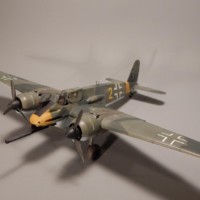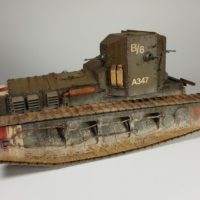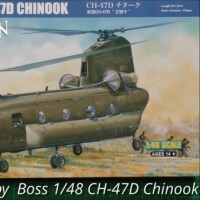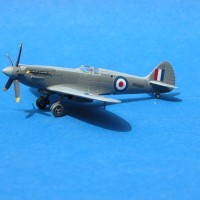Hasegawa 1:48 Bf 109 K-4
I'm not a huge 109 aficionado, but I wanted to do something with RLM 81 Brown-Violet, and I wanted something on which to try out my recently acquired Paasche Raptor airbrush. I settled on the venerable Hasegawa kit, one of two or three in my stash. I know, I know, it's not the new Eduard über kit, but I think it can still yield a nice model.
I used an old True Details resin cockpit set which was a bit clunky to install, but looks pretty good. I also scratchbuilt the hatch at the rear of the cockpit from styrene sheet and stretched sprue. The kit has the fuselage molded with open tail wheel doors, but I wanted them wired shut, as they frequently were, so I cut the doors off and replaced them with styrene strip shaped and filled after the fuselage was together. I also invested in a pair of Quickboost resin exhausts, but I only used the starboard bank since the port side flame shield wouldn't fit over it. You can hardly see the stacks on that side anyway. Although I generally do my airplane models with open canopies, I chose to keep this one closed because the Erla Haube profile, such a prominent distinguishing feature, is more visible this way.
Paints are all Mr. Color with the exception of the RLM 81, which is MRP. The paint job reflects the haste with which planes were assembled at the end of the war, with different sections from different subcontractors in different schemes. The fuselage is 81 Brown-Violet and Dark Green (sometimes called 83; I used 71) over a late-war version of 76, for which I used RAF Sky with a bit of white added. The wings and horizontal tail are 74 Dark Gray and 75 Gray-Violet over 76 Light Blue. The fin and rudder are 75 with dark green blotches over 76.
Decals are mainly from the kit, but I used fuselage crosses with dark green centers from an Eagle Editions sheet. Markings are for Yellow 4 flown by Fw. Hans Strebel, 11./JG 3, Franzfelde airfield near Pasewalk, Germany, March 1945.
Cheers, Pip










That’s excellent, Pip. Those 1990s Hasegawa kits are still great models.
Thanks, John!
There used to be an old saying among photographers, that if you had an "eye," you could take photographs with an Instamatic, and if you didn't, you would take snapshots with a Hasselblad.
You've definitely "taken photographs with an Instamatic" here. Talent, experience and skill on display like this will always come through, regardless of the object on which they are expended.
Very nice work.
Thanks so much, Tom. Actually, I've got a Canon G5X (high end point-and-shoot) that I mount on a tripod and shoot with available (florescent) light in the church room where my club meets. I color-correct in PhotoShop.
Looks like you’ve got that new airbrush dialled in, Pip. Very nice job!
Thank you Ben!
Nothing wrong with those Hase 109's, you have done some sweet work with it. Great paint.
Thank you Bill!
Nice 109, Pip...I'd say you have that new airbrush down solid!
Thank you Joe! I'm not sure yet how I feel about the airbrush. I think I need some more fine line work to figure out pressures and thinning ratios. I'm still more comfortable with my good old Paasche VJR, but it's no longer being produced, so parts may become an issue.
Fantastic result, Pip!
Thank you Spiros!
That' s a wonderful 109, Pip @seawinder
You have used that new airbrush very well. Is the demarcation on the fuselage and the leading wing edges also done free handed.
Thanks very much John. The wing leading edges were masked. The fuselage demarcations are a combination of raised masks, free-hand airbrushing, and brush painting in a couple of small areas.
Beautifully executed camouflage Pip. I too want to do a 109 or 190 using the brown/violet color. The 81/83, 74/75 expedient is interesting and I have seen references for this combination. The thing that has me wondering is the red undercarriage legs. I do not know that much about the finer points of such things. Can you fill me in on the source for the idea of the application?
Hi Russell. Thanks for the comment. The undercarriage legs were painted red to denote the requirement for high octane fuel, presumably for the benefit of ground crew. I don't know how consistently this was applied, but it seems to have been fairly common at least with K-4s.
Learning something new really makes my day. Thanks!
I really like that mixed-scheme scheme! Going to do one like that! Yours came out beautifully.
Great build Pip. I do like the older Hasegawa kits so simple to build but a bit lacking in the old cockpits easily remedied though. Looks a lovely kit
G’day Pip (@seawinder),
This is a great build of what is now a classic kit. I have one in my stash that I will get to one day…
Also, it is a very attractive scheme - which is much of the attraction for late war Luftwaffe aircraft - that is well executed.
Liked!
Nice job, Pip (@seawinder). It is really cool to see these late war camo schemes done so well. I still like building the old Hasegawa kits and they still make good models. Well done.
Interesting scheme!
Thanks all for your comments. They're much appreciated.